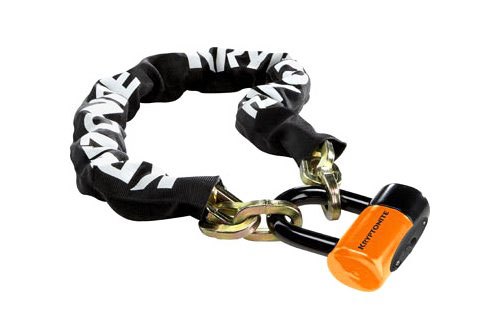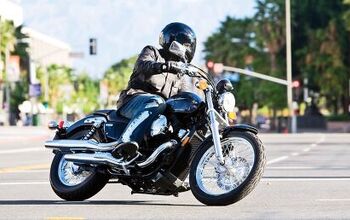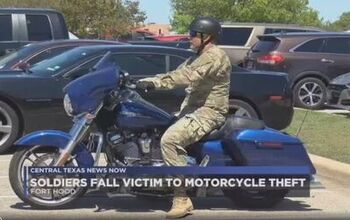Motorcycle Theft Prevention
On average, someone in the U.S. becomes a victim of a motorcycle thief every 11.26 minutes. That’s based on the latest data from the National Insurance Crime Bureau which reported 46,667 motorcycle thefts in the U.S. in 2011.
It’s a devastating feeling, walking out to the curb where you parked your beloved ride and finding nothing left but the flattened soda can you slid under the kickstand.
It really isn’t that difficult to steal a motorcycle. All it takes, essentially, is a couple of guys and a moving van. But there are steps you can take to discourage thieves and prevent becoming another victim of motorcycle theft.
The most important thing to consider is how a motorcycle thief thinks. While there are some thieves who might steal a motorcycle because they want a joyride or to keep it for themselves, most thieves are trying to make a quick and easy profit.
Thieves operate quickly to maximize profit while reducing the chance of getting caught. Given two identical motorcycles, thieves will target the one they think is easier to steal.
A few common-sense tips can help reduce the chances of your motorcycle becoming a target for theft. Locking your ignition and taking the key with you should be obvious, but it’s surprising how often people turn off their engines but forget to lock their steering, making it easy for thieves to wheel their bike away.
It also helps to park in a well-lit location, or even better, somewhere with a nearby security camera. Thieves are more likely to pull their shenanigans in less conspicuous locations. If you have access to a parking garage, use it instead of leaving your motorcycle parked outside, even if you think you’ll only be away for a few minutes.
Also consider various anti-theft devices offered at most motorcycle retailers. Some motorcycle insurance companies offer a discount for anti-theft devices installed on your motorcycle. Discounts vary by carrier and state, so check with your motorcycle insurance company or agent to see if you qualify for a discount.
One popular option is the disc lock. Disc locks are mounted directly onto a brake disc, with a locking pin going through either a cutaway space inside the disc or one of the small holes on the disc itself. The lock should be thick enough so that it will run up against the fork tubes or swingarm, preventing the wheel from turning all the way around. Disc locks come in various sizes to fit different motorcycles and typically cost less than $100. More expensive disc locks offer added features such as an alarm that triggers when the lock senses movement. If you use one, just make sure you remove it before trying to ride away, as the results can be embarrassing and expensive.
Another popular option is a cable or chain that can be strung through wheels or a frame and locked. Most include a sleeve that prevents scratches, and the sleeve is also designed to make it more difficult to cut through a link. These devices, if long enough, can also be attached to a nearby fixed object.
The downside to using a chain or cable is the added weight and bulk of carrying it around, and having to find somewhere to park that’s close enough to a fixed object. Costs for cables and chains vary widely. Cable locks are often cheaper and are considerably easier to carry around than heavy chains.
Using one of these security devices is a good idea, and using both a disc lock and a chain or cable is even better. When selecting a locking device, consider using one in a bright color to help serve as a visual deterrent.
Alarms can also be useful anti-theft tools. Varying in price and complexity, alarms notify everyone within earshot that something is going on, but they won’t help alert you unless you’re nearby. Alarm systems typically use motion or impact sensors to detect when someone is tampering with a motorcycle. Some units also incorporate a current drain sensor that monitors the electrical system to detect when someone is trying to hot wire a motorcycle. More expensive systems can send a text message to your phone if tampered with, which will allow you to investigate even if you’re unable to hear the alarm.
Motorcycle covers can also help prevent thefts while also keeping your seat dry in wet weather. Thieves often target specific models because they plan to sell particular expensive high-demand parts such as exhaust systems, frames and fairings. Keeping your bike covered discourages drive-by hunting, as it’s harder for prospective thieves to identify the motorcycle.
A more modern high-tech option is a vehicle tracking system such as LoJack. These services hide small radio transceivers on motorcycles that can be tracked by law enforcement when reported stolen. When activated, police can quickly track a stolen motorcycle, increasing the chance of recovering it intact. Vehicle tracking systems cost around $650, usually with no monthly monitoring fees. Unfortunately, these services are not always available in all jurisdictions. LoJack’s coverage area, for instance, only includes 28 states.
Motorcycle anti-theft measures can vary widely in cost, but the added security may be well worth the added expense. Above all, remember to use your common sense when parking your motorcycle somewhere, especially in public spaces. Also remember to make sure you have the right insurance protection for your bike in the event that it is stolen.
More by Dennis Chung































Comments
Join the conversation